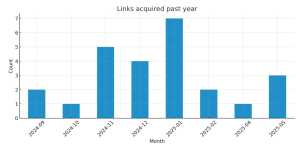In healthcare marketing, it is easy to get caught up in the metrics: rankings, clicks, traffic, and conversions. Yet behind all these numbers are real people. When creating content, keeping this front of mind is essential. In digital PR and healthcare SEO, having content and stories that resonate with patients, professionals, and the wider public makes all the difference in earning visibility. So how do you create content that healthcare audiences and publishers actually want to link to? Let’s explore.
Step 1: Start with your brand goals and objectives
Relevance is one of the most important factors in healthcare SEO, and it is often where organisations make mistakes. Many jump straight into competitor backlink analysis without first considering their own goals and objectives.
By taking the time to understand your priorities, you ensure that every SEO and content decision aligns with wider business strategy. For example, imagine you are a healthcare provider focused on preventative care. A competitor may be generating significant links through a campaign about general wellness, but if your strategic priority is patient education around cardiovascular health, producing content in that space will create far more impact.
This is where you find the balance: authoritative links combined with strong relevance to your healthcare mission and audience needs.
Step 2: Analyse competitor backlinks
Competitor backlink analysis remains a reliable starting point for ideation. Look closely at competitors with the strongest backlink profiles, not just by domain authority but also by traffic, topical relevance, and referring domains. Identify the types of healthcare content attracting links, such as patient resources, data studies, or expert commentary.
Cross-reference these insights with your own content library. This allows you to highlight opportunities, spot gaps, and develop ideas that both meet patient or professional needs and offer link potential.
Bonus tip: Tools such as SEMrush can show you when competitors’ content gains the most links. In healthcare, this often aligns with seasonal events like flu season, awareness days, or new treatment guidelines. By spotting these patterns, you can prepare and publish at the right time.

Step 3: Create a linkable asset content plan
A linkable asset content plan gives structure to your efforts. With your competitor analysis as a foundation, prioritise based on both link-driving potential and healthcare relevance. Include details such as target keywords, patient or practitioner questions (which can be found using SEO tools or search data), and ideal content length based on what already ranks. This ensures your assets are not only engaging but also competitive in search.
Key linkable asset formats for healthcare
- Healthcare Statistics Pages
Curated collections of up-to-date statistics on topics such as disease prevalence, treatment outcomes, or healthcare access provide journalists and researchers with reliable data in one place. - In-Depth Patient or Professional Guides
Step-by-step guides on complex topics, such as “How to Understand Your Lab Results” or “Best Practices for Managing Chronic Conditions,” establish authority and are frequently referenced by healthcare writers. - Medical Infographics
Visual resources explaining conditions, treatment pathways, or prevention methods simplify complex information, making them highly shareable in both media and patient education. - Interactive Tools and Calculators
Tools like BMI calculators, risk assessments, or medication adherence checklists offer lasting value and are frequently cited by health-focused websites.
Original Research and Reports
Proprietary surveys or reports, such as studies on patient behaviour or healthcare technology adoption, position your brand as a thought leader and provide data that journalists and industry analysts rely on.
Key takeaways
Creating linkable healthcare content is a powerful way to build trust, visibility, and authority. When combined with proactive outreach, these assets can generate both short-term coverage and long-term organic visibility.
- Start with your brand goals to ensure healthcare content supports wider objectives.
- Use competitor backlink analysis to uncover proven opportunities and seasonal trends.
- Develop a structured content plan guided by relevance and link potential.
- Focus on proven healthcare formats such as statistics pages, guides, infographics, tools, and original research.
If you need help creating a plan or portfolio of linkable healthcare content, get in touch with our expert Off-page SEO team.

